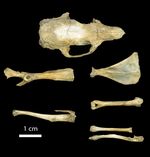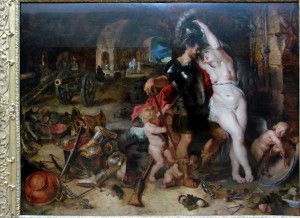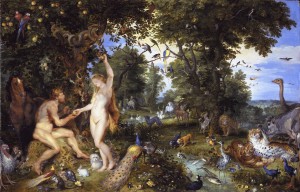 Spanish traders introduced guinea pigs to Europe after the conquest of Peru in 1532. The remains of only three guinea pigs have been discovered in Europe’s archaeological record, and the general historical thought is that those early piggies were exotic pets for the upper classes rather than the common household pet they are today. A new study done on the third archaeological guinea pig skeleton, discovered in Mons, Belgium in 2007, proves that in fact pet cavies were very quickly available to middle class Europeans.
Spanish traders introduced guinea pigs to Europe after the conquest of Peru in 1532. The remains of only three guinea pigs have been discovered in Europe’s archaeological record, and the general historical thought is that those early piggies were exotic pets for the upper classes rather than the common household pet they are today. A new study done on the third archaeological guinea pig skeleton, discovered in Mons, Belgium in 2007, proves that in fact pet cavies were very quickly available to middle class Europeans.
The study, published in April’s Journal of Archaeological Science, examined the remains of the Mons guinea pig. They confirmed that the skeleton belonged to a domesticated guinea pig. (Andean peoples domesticated the wild cavy approximately 7000 years ago, so by the time the Spanish got there the tame pigs had clear morphological differences separating them from their wild cousins.)
Researchers were also able to confirm using radiocarbon dating and the archaeological layers of the site that the animal died at end of the 16th/beginning of the 17th century. Isotope analysis of the Mons pig’s bones found that it ate table scraps, unlike the Andean guinea pigs which subsisted primarily on maize, so in all likelihood it wasn’t a fresh export but rather a guinea pig born and raised in Europe. Also unlike his Andean relatives, this guinea pig was definitely a pet, not a food source. The skeleton was discovered complete, buried in skeleton formation. If it had been eaten, there would have been evidence of butchering and dismemberment. This little guy was tenderly buried in the cellar.
(Not that Europeans at the time didn’t also eat them. They do make an appearance in a book written by French agriculturalist Olivier de Serres in 1563 — he apparently found the flavor less than palatable without the use of copious spices — but that’s the only period reference to guinea pigs as comestibles.)
The new study shows that guinea pigs as pets were more widespread through 16th- and 17th-century society than previously thought, Pigière noted.
That’s because ceramics and glassware found at the Mons archaeological site suggest the house’s residents were middle class, meaning “the animal was available to several classes of populations and not only the aristocrat,” she said.
The earliest of the three archaeological guinea pig skeletons was discovered at Hill Hall in Essex, England, an Elizabethan manor house. The remains date to 1575 or so, when Hill Hall was owned by Thomas Smith, secretary to the Earl of Essex and ambassador to France. The Mons pig was found on the outskirts of the town center in the 16th century. It was a residential village with solid, well-appointed houses, a middle class suburb.
So it seems that the exotic guinea pig, doubtless thanks to its exceptional skill at reproducing early and often, took only a few years to go from manor house pet to suburban denizen.
On a related note, you know who liked guinea pigs? Jan Brueghel the Elder. He put them in several paintings in the 1610s, including at least four of the paintings he made with his friend Peter Paul Rubens (The Garden of Eden, Flora and Zephyr, The Return from War: Mars Disarmed by Venus, Madonna and Child), plus in his own landscapes and still lives like The Entry of the Animals Into Noah’s Ark. He used them to represent fruitfulness, and, in my expert opinion, adorableness.
Art historians think he encountered the New World imports in the royal menagerie in Brussels, and certainly the piggies’ front-and-center placement in mythological and Biblical scenes suggests a prestigious association, but who knows? Maybe he saw guinea pigs in Mons’ Levittown instead.


I cannot refrain from suggesting an edit. This is the sixteenth century, so the “Middle class” as a distinct entity didn’t exist yet. :no: Class is a modern idea. “Middling sorts”, “wealthy commoners”, or “non nobles” are more appropriate terms to describe ‘middling’ people for pre-modern topics. It’s not just semantics; we make a distinction because there is one. 😀
“Middling” implies mediocrity, and “wealthy commoners” presumes, well, wealth. I think “middle class” is an usable, well-established historiographical term to discuss the rise of a moneyed social order between feudal nobility and peasantry. A term doesn’t have to have been current during the period in order to be of use to us now.
Ummm…who knew?! Meanwhile, I can’t help but wonder if three guinea pig skeletons are quite enough to support this great monument of deduction and supposition. Plus Rubens, of course…let’s not forget him! Which makes me wonder about drawings and book illustrations. What were guinea pigs called in the sixteenth and seventeenth centuries–in any or all of the relevant languages? A Google search in English wasn’t much help.
Breughel. Rubens did the people in their collaborative pieces. ‘Twas Jan who loved the pigs, bless his heart. You’re right, though, that the archaeological record on guinea pigs in Europe is thin to the point of anorexia.
They were being called “guinea pigs” in English as early as the 17th century. Olivier de Serres called them “connins d’Inde” in 1600, pairing Columbus’ Indian error with an archaic French term for rabbit. (Same root as coniglio, I suppose.)
Now that I’ve read the comments, I feel a bit like the “middling sort” by gaining satisfaction in simply finding the pigs in the pictures. Where’s Waldo?
I actually included the pig locations in the hovertext over each embedded picture. :giggle: The general rule appears to be guinea pigs front. Whether center, left or right, they’re always in the foreground eating some lettuce adorably.
They weren’t so easy to find. The pigs in the one painting are directly below Mars’ right foot; the pair in the other one are even harder to spot, what with the multitude of animals. They are also almost at the bottom of this painting, just to the right of the end of the peacock’s tail.
OK, now it’s time for all of us to look for the monkey.
Beware! There are Guinea pigs.
A valued comestible in parts of Sth America to be sure but just what do Guinea pigs taste like?
I assume chicken.
… tastes like what appears to be a turkey in “The Entry of the Animals Into Noah’s Ark” (lower right part of the painting) – in maya arithmetic: 31 guinea pigs=1 turkey.
Are there details on the popularity of turkey “for all classes in 16th c. Europe available ?”
:hattip:
Turkeys were definitely luxury items for the upper classes 16th century Europe, but as food, not pets. They were considered superstar banqueting material — they have the fancy look of a peacock for table displays but unlike peacocks they taste good — for royalty, nobility and clergy. They were even the subject of sumptuary laws in Venice.
What do peacocks taste like?
Apparently like gamebirds, ie, pheasants, only they’re stringier and tougher and with a really thick skin. This is why turkey won in the end.
Now that it is discovered that guinea pigs existed in Tudor/Elizabethan England, what did they house them in? 😮
Ferdinand II, archduke of Tirol/Austria, in the 1570ies housed them in a “stibl”(stable) in the garden of his residence in Innsbruck, between two houses for monkeys.
> Echt tierisch. Die Menagerie des Fürsten. Schloss Ambrass. Innsbruck 2015. p.46/56.
(Catalogue to the exhibition)